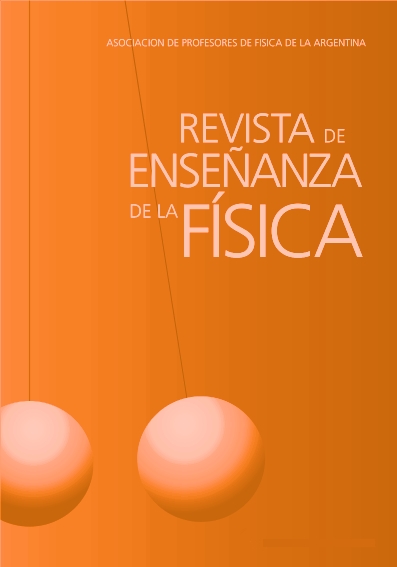Modeling Coriolis Effect on long-range projectiles´ motion
DOI:
https://doi.org/10.55767/2451.6007.v28.n1.14689Keywords:
Modeling, Pseudo-forces, Coriolis Effect, Computational physics, Teaching of classical mechanicsAbstract
Pseudo-forces originated by Earth´s rotation affect the parabolic motion of projectiles moving at the planet´s surface. These forces deviate the howitzers of their launching plane, preventing their arrival to the targeted location. This effect is called the Coriolis Effect and depends on different variables such as shell´s position, velocity, shooting direction, etc. In order to better understand the projectile´s trajectory taking this effect into account, a computational model was developed considering the movement of a shell from a non-inertial reference frame (the Earth) point of view, using the C++ programming language and some numerical methods for the resolution of the equations. Thus, the basic model used for the creation of numerical code allows graphic representation of any conditions showing the dynamic behavior of the projectile. This work further reinforces the importance of computer modeling of dynamic systems on physics education, since it helps students to approach complex physical phenomena with an understandable visual tool.References
Beatty, M. F. (2006). Principles of engineering mechanics: Volume 2 Dynamics - The analysis of motion.Nueva York: Springer.
Buzzo, R. (2007). Estrategia EE (Excel-Euler) en la enseñanza de la Física. Latin-American Journal of Physics Education, 1(1), pp. 19-23.
Franco, A. (2006). Aceleración centrífuga. Recuperado el 5 de mayo de 2014, de Física con ordenador:http://www.sc.ehu.es/sbweb/fisica.htm
Goldstein, H., Poole, C.y Safko, J. (1959). Classical Mechanics. Nueva York: Addison Wesley.
González, A. (2008). Comparación de métodos analíticos y numéricos para la solución del lanzamiento vertical de una bola en el aire. Latin-American Journal of Physics Education, 2(2), pp. 170-179.
Gould, H., Tobochnik, J. y Christian, W. (2007). An introduction to computer simulation methods: Aplication to physical systems.Nueva York: Pearson, Addison Wesley.
Guarín, E. D. y Moreno, H. (2012). La modelación y las visualizaciones computarizadas en la Enseñanza de la Física. Revista Nodos y Nudos, 4(33), pp. 49-61.
McDonald, J. E. (1952). The Coriolis Effect. Scientific American Magazine, (186), pp. 72-76.
Newton, I. (1686). Mathematical Principles of Natural Philosophy and his system of the world.Cambridge: Trinity College.
Resnick, R. y Halliday, D. (1971). Física parte I. Barcelona: CECSA.
Smith, D. C. (2014). Super guns - Part 1.Obtenido de RDECOM, Estados Unidos: U.S. army.
Thompson, E. (1972). Coriolis Deflection of a Ballistic Projectile. American Journal of Physics, 40, pp. 1477-1483.
Wang, A., Li, J., Zhai, X. y Zhang, X. (2010). Study on the effect of Coriolis force on projectile motion based on Matlab. Journal of Shaanxi University of Science & Technology (Natural Science Edition), 6, pp. 106-110.
Downloads
Published
How to Cite
Issue
Section
License
Copyright (c) 2016 Edgar David Guarin, Néstor Méndez-Hincapié

This work is licensed under a Creative Commons Attribution-NonCommercial-NoDerivatives 4.0 International License.
Aquellos autores/as que tengan publicaciones con esta revista, aceptan los términos siguientes:Los autores/as conservarán sus derechos de copiar y redistribuir el material, bajo los términos estipulados en la Licencia de reconocimiento, no comercial, sin obras derivadas de Creative Commons que permite a terceros compartir la obra bajo las siguientes condiciones:
- Reconocimiento — Debe reconocer adecuadamente la autoría, proporcionar un enlace a la licencia e indicar si se han realizado cambios. Puede hacerlo de cualquier manera razonable, pero no de una manera que sugiera que tiene el apoyo del licenciador o lo recibe por el uso que hace.
- NoComercial — No puede utilizar el material para una finalidad comercial.
- SinObraDerivada — Si remezcla, transforma o crea a partir del material, no puede difundir el material modificado.
- Los autores/as podrán adoptar otros acuerdos de licencia no exclusiva de distribución de la versión de la obra publicada (p. ej.: depositarla en un archivo telemático institucional o publicarla en un volumen monográfico) siempre que se indique la publicación inicial en esta revista.
- Se permite y recomienda a los autores/as difundir su obra a través de Internet (p. ej.: en archivos telemáticos institucionales o en su página web) antes y durante el proceso de envío, lo cual puede producir intercambios interesantes y aumentar las citas de la obra publicada. (Véase El efecto del acceso abierto).














